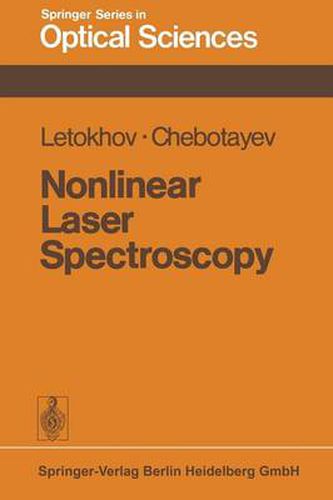Readings Newsletter
Become a Readings Member to make your shopping experience even easier.
Sign in or sign up for free!
You’re not far away from qualifying for FREE standard shipping within Australia
You’ve qualified for FREE standard shipping within Australia
The cart is loading…






This title is printed to order. This book may have been self-published. If so, we cannot guarantee the quality of the content. In the main most books will have gone through the editing process however some may not. We therefore suggest that you be aware of this before ordering this book. If in doubt check either the author or publisher’s details as we are unable to accept any returns unless they are faulty. Please contact us if you have any questions.
The laser as a source of coherent optical radiation has made it possible to investigate nonlinear interaction of optical radiation with atoms and mole cules. Its availability has given rise to new research fields, such as non linear optics, laser spectroscopy, laser photochemistry, that lie at the boundary between quantum electronics and physical optics, optical spectros copy and photochemistry, respectively. The use of coherent optical radiation in each of these fields has led to the discovery of qualitatively ne\~ effects and possibilities; in particular, some rather subtle effects of interaction between highly monochromatic light and atoms and molecules, in optical spec troscopy, have formed the bases for certain methods of so-called nonlinear, laser Doppler-free spectroscopy. These methods have made it possible to in 5 6 crease the resolution of spectroscopic studies from between 10 and 10 , lim 11 ited by Doppl er 1 i ne broadeni ng up, to about 10 ; at present some 1 abor atories are developing new techniques that have even higher resolution. The discovery and elaboration of the methods of nonlinear laser spectroscopy have resulted largely from contributions by scientists from many countries, in particular from the USA (Massachusetts Institute of Technology, Stanford Uni versity, National Bureau of Standards in Boulder, Harvard University, etc. ), the USSR (P. N. Levedev Institute of Physics, Institute of Semiconductor Phys ics in Novosibirsk, Institute of Spectroscopy, etc.
$9.00 standard shipping within Australia
FREE standard shipping within Australia for orders over $100.00
Express & International shipping calculated at checkout
This title is printed to order. This book may have been self-published. If so, we cannot guarantee the quality of the content. In the main most books will have gone through the editing process however some may not. We therefore suggest that you be aware of this before ordering this book. If in doubt check either the author or publisher’s details as we are unable to accept any returns unless they are faulty. Please contact us if you have any questions.
The laser as a source of coherent optical radiation has made it possible to investigate nonlinear interaction of optical radiation with atoms and mole cules. Its availability has given rise to new research fields, such as non linear optics, laser spectroscopy, laser photochemistry, that lie at the boundary between quantum electronics and physical optics, optical spectros copy and photochemistry, respectively. The use of coherent optical radiation in each of these fields has led to the discovery of qualitatively ne\~ effects and possibilities; in particular, some rather subtle effects of interaction between highly monochromatic light and atoms and molecules, in optical spec troscopy, have formed the bases for certain methods of so-called nonlinear, laser Doppler-free spectroscopy. These methods have made it possible to in 5 6 crease the resolution of spectroscopic studies from between 10 and 10 , lim 11 ited by Doppl er 1 i ne broadeni ng up, to about 10 ; at present some 1 abor atories are developing new techniques that have even higher resolution. The discovery and elaboration of the methods of nonlinear laser spectroscopy have resulted largely from contributions by scientists from many countries, in particular from the USA (Massachusetts Institute of Technology, Stanford Uni versity, National Bureau of Standards in Boulder, Harvard University, etc. ), the USSR (P. N. Levedev Institute of Physics, Institute of Semiconductor Phys ics in Novosibirsk, Institute of Spectroscopy, etc.